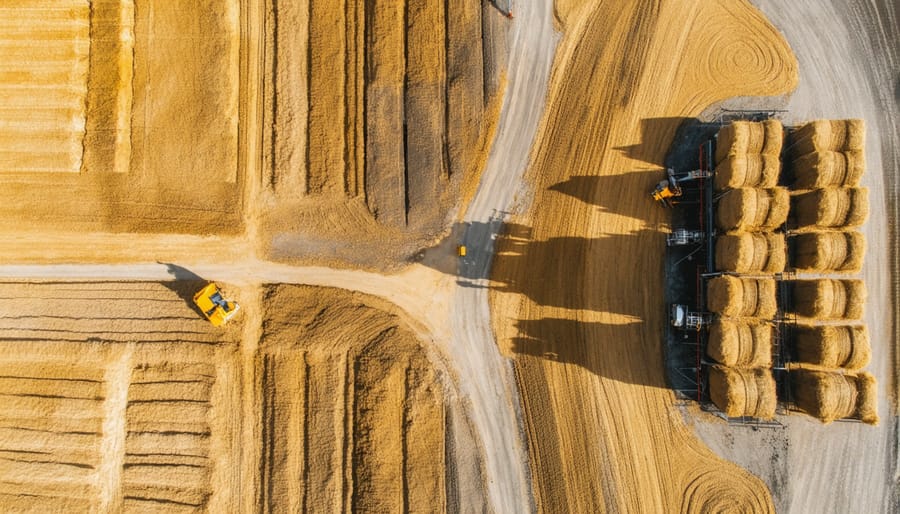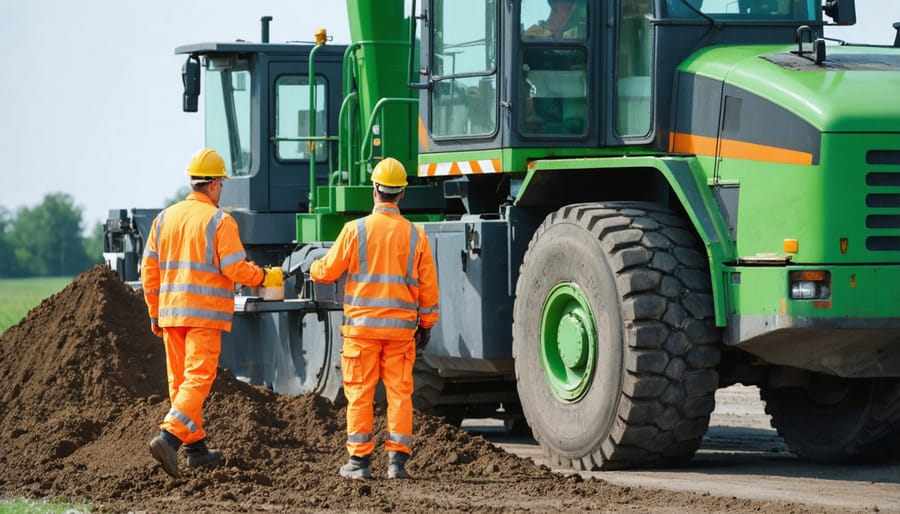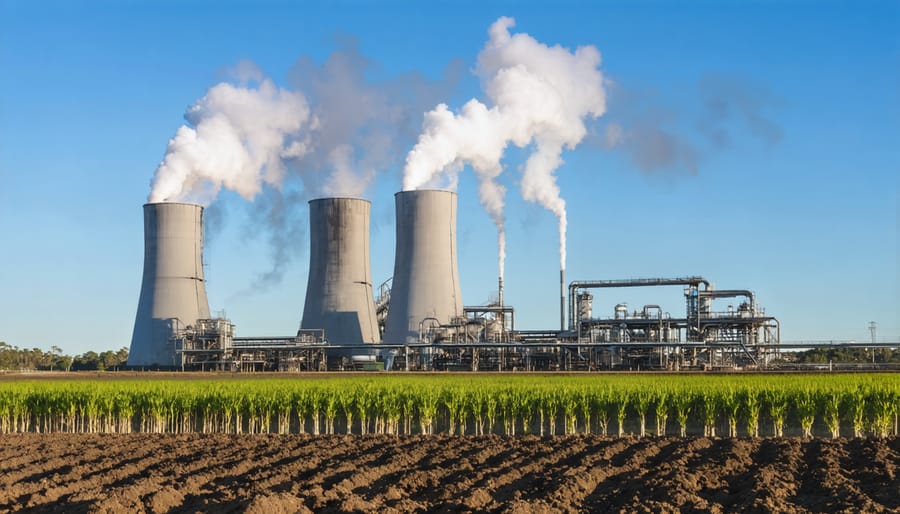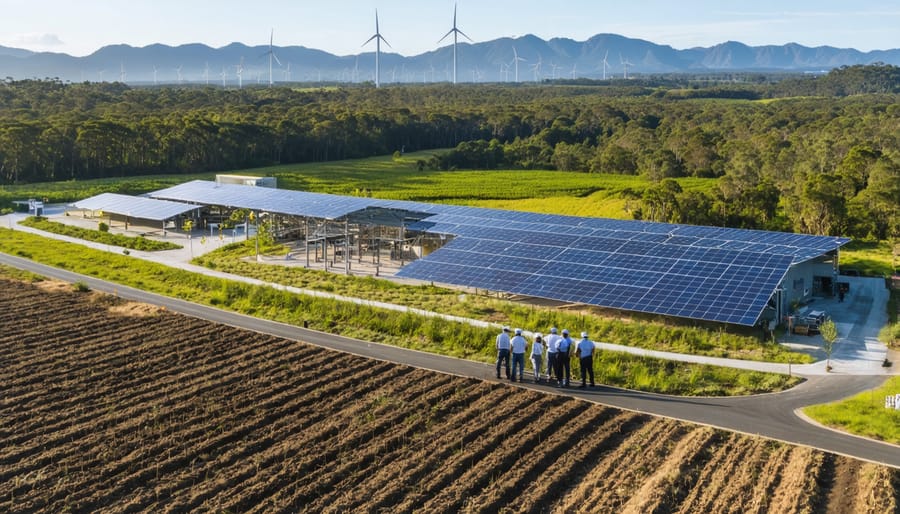Transforming Australia’s renewable energy landscape, bioenergy emerges as a powerful catalyst for regional economic growth and sustainable development. From sugarcane waste in Queensland to forestry residues in Tasmania, our nation’s abundant biomass resources are revolutionizing how we think about energy production and rural prosperity. Bio Energy Development Inc. and other industry leaders have demonstrated that converting agricultural by-products into clean energy not only reduces carbon emissions but also creates lasting jobs and revenue streams for farming communities.
With bioenergy projects already contributing over $2.5 billion to our national economy and supporting thousands of regional jobs, this renewable resource represents a unique opportunity to strengthen Australia’s energy independence while empowering local communities. The convergence of advanced technology, supportive policies, and growing market demand has positioned our agricultural sector to lead the Asia-Pacific region in sustainable bioenergy production, offering a blueprint for combining environmental stewardship with economic prosperity.
As global demand for renewable energy solutions continues to surge, Australia’s bioenergy sector stands ready to capitalize on our natural advantages and agricultural expertise, promising a future where clean energy and rural development go hand in hand.
The Power of Local Resources: Australia’s Bioenergy Advantage
Agricultural Waste to Energy Gold
In the heartland of agricultural regions, a remarkable transformation is taking place as farmers turn what was once considered waste into valuable energy gold. Through innovative renewable energy initiatives, agricultural by-products like corn stalks, rice hulls, and sugarcane bagasse are being converted into clean, sustainable energy sources.
This waste-to-energy conversion is particularly promising for Australian farmers, who can now create additional revenue streams while reducing disposal costs. For instance, in Queensland’s sugar-growing regions, mills are using bagasse to generate electricity, powering their operations and feeding surplus energy back into the grid.
The process isn’t limited to crop waste either. Livestock manure is being transformed into biogas through anaerobic digestion, providing farms with heat and electricity while reducing methane emissions. Some forward-thinking dairy farms have already implemented these systems, achieving energy independence and creating a circular economy model that other agricultural businesses are keen to follow.
This agricultural waste conversion represents a win-win solution, addressing both waste management challenges and energy needs while supporting regional development and sustainability goals.

Forest Industry Biomass Opportunities
The forest industry presents a goldmine of opportunity for bioenergy production through sustainable waste management. Sawmills, timber processing facilities, and forestry operations generate significant amounts of residual materials – from sawdust and wood chips to bark and logging residues – that can be transformed into valuable bioenergy resources.
In sustainable forestry practices, these materials, which would otherwise go unused, are collected and processed into wood pellets, chips, or directly used for heat and power generation. This approach not only reduces waste but also creates additional revenue streams for forestry businesses while supporting renewable energy goals.
Many timber mills have already embraced this opportunity by installing biomass boilers to power their operations, achieving energy independence while reducing operational costs. The integration of forest biomass collection into existing harvesting operations has proven particularly successful, with some facilities reporting up to 30% reduction in energy expenses.
Looking ahead, the forest industry’s biomass potential could play a crucial role in Australia’s renewable energy mix, particularly in regional areas where forestry operations are concentrated. This creates a win-win situation: sustainable waste management combined with clean energy production.
Regional Job Creation and Economic Benefits

Direct Employment Impact
The bioenergy sector stands as a significant job creator in the US economy, generating employment opportunities across multiple skill levels and industries. From plant operators and technicians to logistics specialists and agricultural workers, the sector provides diverse career pathways that support local communities.
Direct employment in bioenergy facilities typically creates 15-20 permanent positions per facility, with larger installations supporting up to 35 full-time roles. These positions offer competitive wages, averaging 20% higher than regional median incomes in rural areas. What’s particularly encouraging is that many of these jobs are accessible to workers transitioning from traditional energy sectors, requiring similar skill sets and technical knowledge.
The supply chain impact multiplies these employment figures significantly. For every direct job in a bioenergy facility, approximately 2.5 additional positions are created in related industries. These include roles in feedstock collection, transportation, equipment manufacturing, and maintenance services. Farmers and forestry workers benefit from new revenue streams, while local trucking companies see increased demand for their services.
Success stories from states like Iowa and Minnesota demonstrate how bioenergy projects can rejuvenate rural economies. For instance, a single 50-megawatt biomass power plant can support up to 100 indirect jobs in the surrounding community, from agricultural suppliers to service providers. This ripple effect strengthens local economies and helps retain younger workers who might otherwise leave for urban areas.
Indirect Economic Benefits
The ripple effects of bioenergy projects extend far beyond direct employment and energy production. When a bioenergy facility establishes itself in a regional area, it creates a cascade of economic opportunities for local businesses. Transport companies benefit from increased demand for biomass collection and delivery services, while agricultural suppliers see growth in equipment sales and maintenance services.
Local cafes, accommodation providers, and retail stores experience increased foot traffic from workers and visitors to bioenergy facilities. In towns like Colac, Victoria, where biomass projects have taken root, small businesses report up to 15% increases in revenue following project establishment. These facilities also contribute to agricultural diversification, allowing farmers to generate additional income by selling crop residues and organic waste materials.
The presence of bioenergy projects often attracts complementary industries, creating business clusters that strengthen regional economies. For instance, food processing plants may establish nearby to take advantage of the stable energy supply and waste management solutions. This clustering effect has been particularly successful in agricultural regions, where waste-to-energy facilities serve as anchors for broader industrial development.
Educational institutions also benefit through increased demand for training programs and research partnerships. Technical colleges often develop specialized courses in renewable energy operations, creating pathways for local youth to secure skilled employment without leaving their communities. This knowledge retention helps build sustainable, resilient regional economies for the future.
Success Stories: Australian Communities Leading the Way
The Mount Gambier Biomass Success
Mount Gambier’s transformation into a bioenergy hub stands as a shining example of how regional communities can embrace sustainable energy solutions while boosting local economic growth. The project, initiated in 2019, has successfully converted forestry waste from the region’s extensive timber industry into clean, renewable energy.
The facility processes over 100,000 tonnes of wood waste annually, generating enough power to supply 5,000 homes while creating 40 permanent local jobs. What makes this project particularly remarkable is its circular economy approach – waste materials that would otherwise be burned or left to decompose are now providing valuable energy resources.
Local businesses have reported significant cost savings since connecting to the biomass plant. The Mount Gambier Timber Processing Plant, for instance, has reduced its energy costs by 30% while simultaneously solving its waste disposal challenges. The project has also attracted new industries to the region, with several agricultural processing facilities choosing to establish operations near the biomass plant to take advantage of the reliable, affordable energy supply.
Community engagement has been crucial to the project’s success. Regular open days and education programs have helped residents understand the benefits of bioenergy, leading to strong local support. The facility has become a model for other regional communities, with delegations from across Australia visiting to learn from Mount Gambier’s experience.
The project demonstrates how strategic investment in bioenergy can create a triple-win situation: environmental benefits through waste reduction, economic advantages through job creation and cost savings, and social benefits through community empowerment and education.

Queensland’s Sugar Industry Revolution
Queensland’s sugar industry has undergone a remarkable transformation in recent years, emerging as a leading example of sustainable bioenergy production in Australia. The state’s sugar mills have revolutionized their operations by harnessing bagasse – the fibrous material left after crushing sugarcane – to generate both heat and electricity.
A standout example is the Mackay Sugar Limited’s Racecourse Mill, which generates enough electricity from bagasse to power its entire milling operation and export surplus energy to the grid, providing renewable power for approximately 28,000 homes. This innovative approach has created a win-win situation: the mill reduces waste, cuts operational costs, and contributes to Australia’s renewable energy targets.
The success of Queensland’s sugar industry in bioenergy production has sparked interest across the agricultural sector. Mills across the region have invested in high-efficiency boilers and modern turbines, maximizing the energy potential of their bagasse resources. During the crushing season, these facilities operate as hybrid businesses – producing sugar while simultaneously functioning as power stations.
The economic benefits have been substantial. Sugar mills have developed new revenue streams, created additional employment opportunities, and strengthened regional economies. Moreover, the industry’s transition to bioenergy has significantly reduced its carbon footprint, with some mills achieving carbon-neutral status during crushing season.
This transformation serves as a blueprint for other agricultural industries looking to embrace sustainable practices while maintaining profitability. The Queensland sugar industry’s success demonstrates how traditional agricultural operations can evolve to meet modern energy challenges while supporting regional development and environmental sustainability.
Future Growth Potential and Implementation Strategies
Identifying Regional Opportunities
Identifying regional opportunities for bioenergy development requires a systematic approach that considers local resources, infrastructure, and community needs. Start by conducting a comprehensive biomass audit of your region, taking stock of agricultural waste, forestry residues, and organic municipal waste. These assessments help determine the most viable feedstock options for your area.
Consider partnering with local farmers and agricultural businesses to establish reliable biomass supply chains. Many regions have untapped potential in crop residues, animal waste, or food processing byproducts that could fuel bioenergy projects. For example, sugar cane regions in Queensland have successfully utilized bagasse for power generation, creating a model for other agricultural areas.
Infrastructure assessment is equally crucial. Evaluate existing power grid connections, transport networks, and processing facilities. Some regions might benefit from smaller, distributed bioenergy systems, while others could support larger-scale operations.
Community engagement plays a vital role in identifying opportunities. Local councils and business chambers often have valuable insights into energy needs and potential partnerships. Look for areas where bioenergy could solve multiple challenges, such as waste management issues while providing renewable energy.
Don’t overlook the potential for job creation and economic growth. Many regional communities have revitalized their economies through smart bioenergy initiatives, creating new employment opportunities and sustainable revenue streams.
Building Community Support
Building community support for bioenergy projects requires a collaborative approach that brings together local stakeholders, businesses, and government bodies. Success stories from regional areas like Goulburn Valley and Mount Gambier demonstrate how community engagement leads to sustainable outcomes.
Key to gaining local backing is transparent communication about the benefits bioenergy brings to communities. These include job creation, reduced waste management costs, and energy independence. Town hall meetings, educational workshops, and site visits to existing facilities have proven effective in building understanding and trust.
Local councils play a vital role by establishing community consultation frameworks and facilitating partnerships between farmers, waste management facilities, and energy providers. The formation of bioenergy cooperatives, where community members can invest directly in projects, has been particularly successful in regions like the Riverina.
Financial institutions are increasingly supporting bioenergy initiatives through green loans and investment packages. This support, combined with government grants and incentives, makes projects more accessible to communities. Agricultural communities have found particular success by pooling resources and sharing infrastructure costs.
To maintain momentum, successful projects often establish demonstration sites where residents can see bioenergy in action. Regular progress updates, community newsletters, and local media coverage help keep stakeholders informed and engaged. Schools and TAFE programs incorporating bioenergy education help cultivate long-term community support and develop future industry professionals.
As we look to the future of regional Australia, bioenergy stands as a beacon of transformative potential, offering a pathway to sustainable economic growth and environmental stewardship. The success stories we’ve witnessed across various communities demonstrate that bioenergy isn’t just an alternative energy source – it’s a catalyst for regional revival.
From agricultural waste conversion in the Riverina to forestry residue utilization in Tasmania, these initiatives are creating new job opportunities, diversifying farm income, and building more resilient local economies. The ripple effects extend far beyond energy production, fostering innovation hubs, attracting investment, and creating skilled employment opportunities that help retain young talent in regional areas.
The beauty of bioenergy lies in its ability to turn challenges into opportunities. Waste management issues become energy solutions, agricultural by-products transform into valuable resources, and carbon reduction goals align with economic growth objectives. This symbiotic relationship between environmental sustainability and economic development is precisely what makes bioenergy such a compelling proposition for regional Australia.
Looking ahead, the potential for growth is enormous. With continued investment in research, development, and infrastructure, regional Australia could become a world leader in bioenergy innovation. The foundations are already in place – abundant biomass resources, strong agricultural expertise, and communities eager to embrace sustainable solutions.
As we embrace this bioenergy revolution, we’re not just creating a cleaner energy future; we’re building stronger, more prosperous regional communities that will thrive for generations to come.

